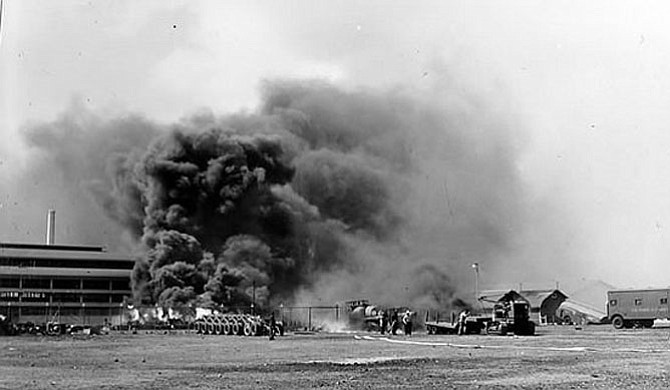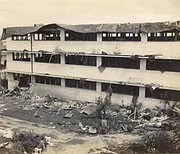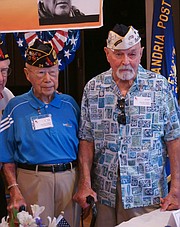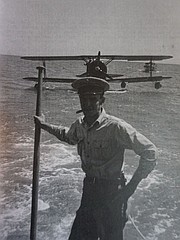CWO Jay Groff was in the third floor of the barracks (left) of Hickam Air Force Base when it was attacked on Dec. 7, 1941. He still has his footlocker that was salvaged from the wreckage. Photo Contributed
They said it couldn’t be done. There had never been anything like it in the history of warfare but with unmistakable red spheres visible on every wing, 353 Japanese planes descended undetected over the islands of Hawaii on a sleepy Sunday morning. It was Dec. 7, 1941 — the “date that will live in infamy.”
“The Japanese timed it perfectly,” said Jay Groff, who was preparing to head to his duty station at Hawaii’s Hickam Air Force Base when Pearl Harbor was suddenly attacked. “We didn’t believe a sneak attack was possible. We were told — and believed — that the islands were impregnable and that no one could get close to us. We were a victim of our own propaganda.”
“To do our duty was all that mattered. We responded to the challenge.” — Pearl Harbor survivor Jay Groff
At the time, Groff was a 19-year-old chief warrant officer serving in the Army Air Corps Rescue Boat Service. Now 94 years old, he remembers vividly that moment 75 years ago when “hell came raining down on us.”
“Most of us were still asleep in our bunks on what was a typical Hawaiian morning,” said Groff. “A few lucky ones were on leave in Honolulu, money still jingling in their pockets from payday a few days earlier. I was still in my skivvies when the first bomb landed outside the barracks.”
The Japanese attack on Pearl Harbor came in two waves. The first hit its target at 7:53 a.m. followed by a second wave an hour later. Within 90 minutes it was over. Left behind was chaos: 2,403 Americans dead with another 1,178 wounded; 188 destroyed planes and a Pacific Fleet crippled by eight damaged or destroyed battleships. In one stroke the Japanese propelled the United States into World War II.
“When the bombs began to fall, personal security was forgotten,” Groff said at a recent Rotary Club of Alexandria luncheon. “That was the first time I was scared. I could see the bombs coming through the ceiling. But to do our duty was all that mattered. We responded to the challenge.”
As Japanese Zeros strafed the base with gunfire, Groff headed to a baseball field to help set up machine guns. He eventually made his way to the roof of his boathouse duty station, where he manned a machine gun. It was there he saw an unarmed American B-17 bomber try to land on the runway just beyond his station.
"The Zeros' rounds hit a flare box in the B-17,” Groff recalled. “By the time it finished rolling the plane had burned in half."
Hickam Air Force Base was one of Japan’s primary targets during the attack on Pearl Harbor. As a result, it suffered extensive damage, aircraft losses and loss of life with 189 people killed and 303 wounded.
“We didn’t realize at the time that day would become such a significant part of world history,” Groff said.
Col. Kim Ching (ret.), a member of American Legion Post 24 in Old Town, was a teenager living in Honolulu with his family when the attacks occurred.
“No one knew what was happening,” said Ching. “I had an uncle in the Hawaii Territorial Guard so we were getting a little more information than others but that day was one of stunned chaos and confusion.”
In the wake of the attacks, Ching received permission from his mother to join the military just shy of his 17th birthday. Four years later he would be among the troops standing on the deck of the USS Missouri to witness the signing of the Japanese Instrument of Surrender.
“There aren’t many of us left who remember that day,” Ching said. “It is only because of God’s grace that I am here while others are not.”
At the time of the attacks, there were more than 80,000 U.S. service members living on Oahu. It is believed that fewer than 2,000 are still alive today.
“Our ranks are growing thinner each day,” said Groff, who will lay a wreath at the WWII Memorial in Washington as part of the formal 75th anniversary ceremonies on Dec. 7. “It’s important to remember those who fought in the Battle of Pearl Harbor and survived that day of infamy. These are the men and women who were at the forefront of our nation’s Greatest Generation.”





